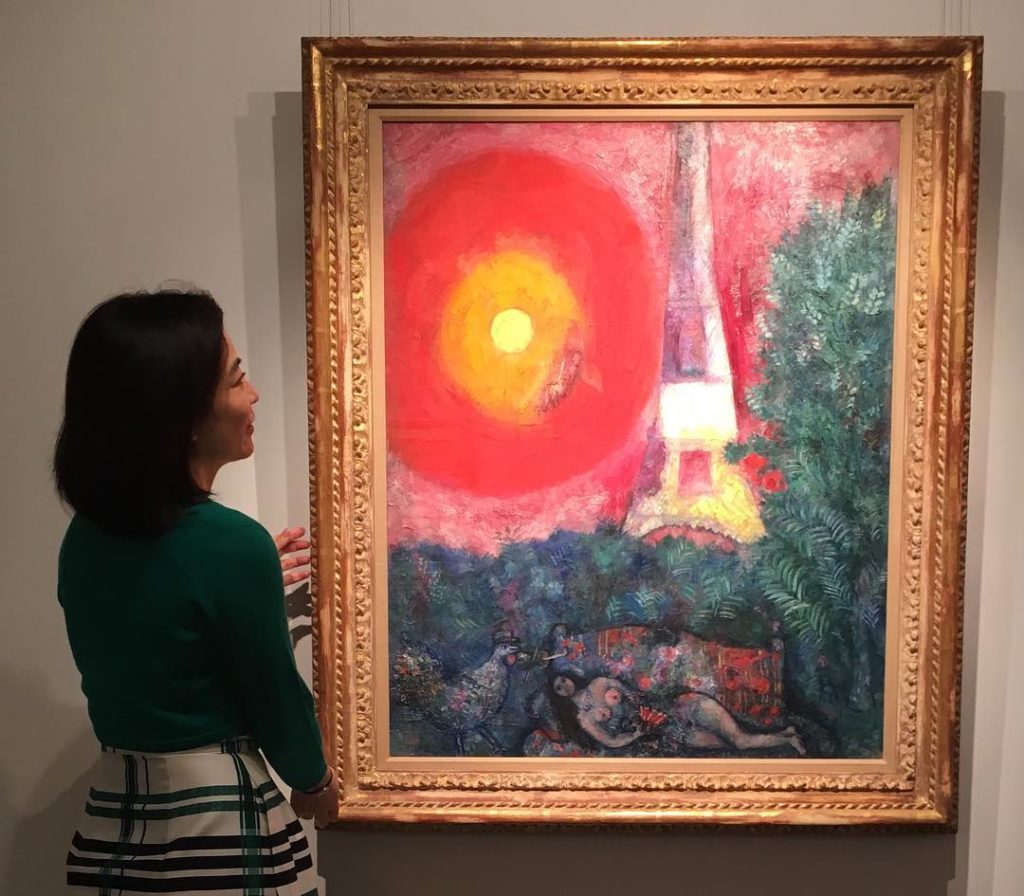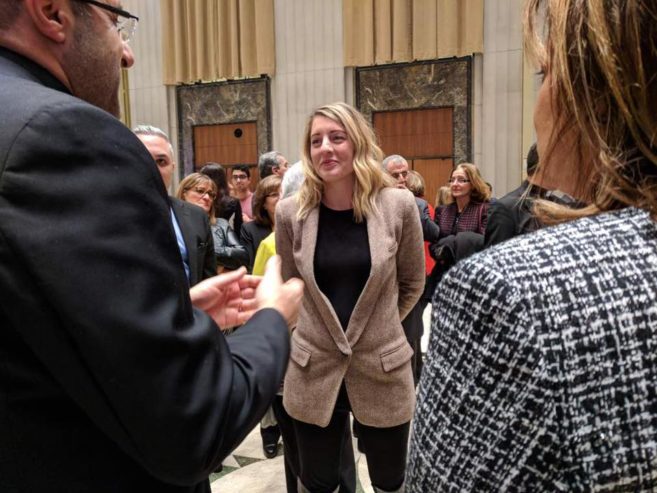Once the machinery of an international auction has been set in motion, it can be hard to stop. But some Canadians are trying.
So far, hundreds of people have signed a petition titled “Do not sell Marc Chagall’s “The Eiffel Tower” (1929) from the National Gallery of Canada.”
And if the petitioners fail at halting the auction, they at least hope to call for better transparency and public engagement regarding deaccessioning at the National Gallery of Canada.
“It [the NGC’s Chagall deaccession] was not a transparent decision; it was not discussed with the public,” says petition creator Natalia Abramova, an art-loving mother of two who lives and works in Vaughan, Ontario. “If Christie’s hadn’t published a press release about it, we would not have found out.” She wonders: “Why so secretive?”
Indeed, the March 21, 2018, Christie’s press release was the first public indication that the Chagall deaccession (signed off on in June 2017, apparently) had taken place. It took a CBC Freedom of Information request, which came to light in early April 2018, for the public to know that eight other objects were being deaccessioned from the collection, too.
It wasn’t until after the deaccessions hit CBC’s The World at Six and National on April 4 that the National Gallery began doing media interviews on the matter. And today there is still no information available on the gallery’s website about the deaccession and reasons for it.
The lack of transparency has left Abramova shaken in terms of trust in her national art institution.
“Today they are selling Chagall,” she says. “Tomorrow, will they be selling Group of Seven because they need it for something else?”
Breaking news items indicate that directors of some Canadian museums are also upset with the National Gallery’s lack of collaboration and communication in this matter, and are feeling concerned about the opaque process.
Musée des beaux-arts de Montreal director Nathalie Bondil recently told Le Devoir, “Why, when you have $8 million to spend on acquisitions, would you sell a work, a Chagall? Eight million, that’s a lot…. I swear I don’t understand it. The ideal would be to keep a beautiful Chagall at the National Gallery, and share the [proposed acquisition, currently rumoured to be a David] between three museums?” Bondil noted the Musée de civilisation du Québec was also interested in such a partnership.
Canadian Museums Association Guidelines Call for Transparency
The Canadian Museums Association’s Deaccessioning Guidelines, created in 2014 and available online, recommend transparency, communication and consultation in the deaccessioning process—often with an eye to maintaining public trust.
In addition to consulting with insiders like staff, donors and funders on deaccessioning choices, the Canadian Museums Association guidelines recommend that “institutions should consult with other individuals who have a vested interest in the respective collection. Stakeholders may include visitors [and] researchers…. Consideration should be given to striking a panel of stakeholders ensuring that the objective of openness and transparency in the deaccessioning process are met.”
Once the decision to deaccession has been made, the Canadian Museums Association Guidelines recommend that a gallery should “ensure complete transparency and communicate the disposal to the public” as well as “develop a communications strategy.”
The Canadian Museums Association Guidelines also note that the deaccessioning of an object is unacceptable when the “primary need is for financial reasons.”
National Gallery Says It Followed Standard Processes
In response to emailed questions about transparency in the Chagall deaccession process, a National Gallery of Canada spokesperson stated that “the gallery follows a rigid acquisition and de-accession process that meet national and international professional standards.”
In its own dispositions policy, the National Gallery refers not to the more recent Canadian Museums Association Guidelines, but rather guidelines developed some years earlier: the Association of Art Museum Directors’ Policy on Deaccessioning (2010) and the Canadian Art Museum Directors’ Organization’s Deaccessioning Guidelines (May 2007).
The National Gallery also stated via email: “De-accessioning is a thoughtful, considered process. It is driven by scholarship and knowledge of the Gallery’s collection and needs. Decisions are made carefully: a plurality of the Board of Trustees must approve after consultation with the Gallery’s Director, Chief Curator, the staff charged with the work’s care, and with independent advisors. The decision to de-accession The Eiffel Tower was made carefully and with full knowledge of the collection’s needs.”
In a general statement to those who are concerned about the Chagall acquisition and the precedent it might set, the gallery said, “Thank you for your interest in the National Gallery of Canada’s pending acquisition. The Gallery follows a rigorous acquisition and de-accession process. Part of that process is not to discuss details around acquisitions while in progress. Furthermore, the owners of the artwork have asked us not to talk about the artwork at this time, and we are respecting their wishes. We will gladly share this information with you once the purchase is confirmed. Thank you for your patience.”
In National Gallery Policy, Transparency Criteria Seem Minimal
In terms of public communication and transparency, the National Gallery’s disposition policy (which governs deaccessions and related activity) seem spare, especially when compared to the Canadian Museums Association Guidelines.
“Attention will be given to transparency throughout the process,” says the NGC Disposition Policy. But it does not indicate how that transparency is to be enacted or achieved.
In terms of public communication, the policy says, “De-accessioned works will be listed in the relevant Annual Report, with the method of disposal and outcome noted. In addition, this information will be posted on the Gallery’s public website.” But it does not list deadlines for that web posting, nor how members of the public will be made aware of that website information.
Board and Staff Turnover at Gallery Contributes to Confusion
Recent and projected board and staff turnover at the gallery also raises questions about who remains accountable for Chagall deaccession decision and its public fallout.
The National Gallery of Canada Disposition Policy says “primary accountability for implementation of this policy rests with the Chief Curator and Deputy Director, Collections and Research, under the direction of the Gallery’s Director and CEO.”
But chief curator and deputy director Paul Lang left the National Gallery in March, after being with the gallery since 2011, Artsfile reports. Though Lang’s departure had been in the air for some months—namely, for a return to Lang’s home country of France and a museum job there—March was, coincidentally, the same month Christie’s was sending out the press release that would lead to public outcry.
Also, it has recently been confirmed by Artsfile and others that National Gallery of Canada director and CEO Marc Mayer is planning to leave the gallery at the end of his current, second term in early 2019. Mayer has had many commendable triumphs during his decade at the gallery—including the initiation of a quinquennial of Indigenous art, the reviving of a Canadian Biennial, and the renewed leadership of the Canada Pavilion in Venice. But public reception to the Chagall decision has so far proved difficult. It’s likely long-term public-trust fallout of that will be transferred to a successor.
The NGC Dispositions policy also states that “The final authority for deaccessioning and disposal of art rests with the Board of Trustees, on the recommendation of the Board’s Acquisitions Committee and with the advice of the director and CEO. Approval requires a two-thirds majority of trustees present.”
At first that policy seems clear. Also clear is the gallery’s assertion, on its website, that its board of trustees has 11 members. But the fact is that the Ministry of Canadian Heritage—whose job it is to appoint trustees to the National Gallery of Canada board, as well as the boards of other national museums—has been sorely behind its trustee-appointment duties in recent years.
That means that when the Chagall deaccession decision was made by the NGC board in June 2017, the board had only eight members, not 11. And three of these members had terms that were supposed to have ended in 2016—but were still waiting, as per the Museums Act, to be replaced by the Ministry of Canadian Heritage appointments process.
On March 20, 2018, the day before the Christie’s press release was issued, the Ministry of Canadian Heritage at last announced a variety of appointments that are due to bring the National Gallery of Canada’s board membership to 10 term-correct members by June 1, 2018. Yet seven of these members will be relatively new, with no direct experience of the Chagall deaccession, nor any say in how that decision was made.
The Art Market vs. Transparency
Of course, any attempt to bring transparency to the art market—a market which is famously resistant to clarity and openness—is difficult, even in the context of public institution sales and acquisitions.
“Discretion” is often the word relayed when requests for art prices are made, whether at art fairs or in other contexts. And even if prices are displayed openly, viewers never know if the purchaser received a similarly “discreet” discount.
The only time one can know for sure what price an artwork fetched is when it comes to auction—and even then, it can be impossible to find out who actually bought it.
“If you bring too much transparency to the market, you risk harming the mythmaking machine that makes prices so high,” Brussels-based collector Alain Servais told the New York Times earlier this year. “You are no longer part of a clique. Art becomes a common thing.” (On a more illegitimate note, an anonymous London gallerist once told Artnet News that “we don’t like to speak about prices to prevent our clients’ spouses or the tax authorities from finding out about their purchases.”)
Whatever the reason for secrecy, it’s no mistake that art has been called the “most opaque of luxury businesses.” And that affects how all kinds of public institutions engage with it, and communicate about it with audiences.
But it’s not just National Gallery petitioners who are demanding more transparency in the art world.
“We are disrupting the art market by making it more transparent,” Magnus Resch, creator of the Magnus app (kind of like Shazam for artworks) has told the New York Times. “My generation wants all information immediately, and not to go through a beauty contest while waiting for the director of the gallery to come and check me out.”
Whether large art institutions—who are often, by necessity, slow moving, considered, and behind-the-scenes in their activities, acquisition or otherwise—will one day, along with the faster moving but no less opaque art market, adjust to the on-demand transparency expectations of digital natives remains an open question.
What’s Next With Deaccessioning Ramping Up in Future
A November 2017 briefing note to Heritage Minister Mélanie Joly, obtained by CBC News, states that the recent NGC deaccessions, Chagall included, “mark the beginning of a new disposition policy that will increase the frequency of the National Gallery sales and donations.”
It’s a trend other Canadian museums may be picking up on too—part of a surge of interest in high-profile deaccessioning that some trace to former Art Gallery of Ontario European art curator Lloyd DeWitt. DeWitt is now chief curator at the Chrysler Museum in Virginia.
As Maclean’s reported in 2016, DeWitt, during his time at the AGO, cleared out some 65 pieces from the gallery’s European painting collection—roughly 20 percent of those holdings. The sale proceeds, in part, went to buy a Hammershoi, Interior with Four Etchings.
DeWitt also presented a “disconcertingly popular” deaccessioning session at the 2015 Canadian Museums Association conference, Maclean’s reports.
One hopes that it’s not only deaccessioning that’s on the rise—but new ways to be transparent and engaged about it in regard to the public.
According to that 2016 article in Maclean’s, there are definitely ways out there to engage the public better: “The Indianapolis Museum of Art … has a searchable online database (currently listing 6,199 disposed items).” And “the Georgia Museum of Art garnered criticism from the art world a few years ago when it sought public input before deaccessioning four works by Bernard Smol. After the vote, it kept two, including the one the public liked most.”
For her part, Abramova, like many other members of the public, is still waiting for a chance to have greater, more transparent access to Canada’s art successes and challenges.
“I don’t understand it,” Abramova says. “If such a piece of national heritage deserves to be in the country, then let us know about it, and let’s do fundraising, crowdfunding, whatever.” She adds: “Let us decide together what to do next.”
The National Gallery, for its part, says that no official disclosure of the national-heritage-value work it is seeking will be made until at least May 15—the date of the Christie’s Chagall sale.
A clarification was made to this article on April 16, 2018: namely, changing the Natalia Abramova quote “Why so secret?” to “Why so secretive?”
This article was updated on August 8, 2021 to correct an error. Lloyd DeWitt was incorrectly identified as American. Although he is correctly identified as the chief curator at the Chrysler Museum in Virginia, he was born in Canada and holds only a Canadian citizenship. We sincerely regret the error.

 By the time most Canadians realized Chagall's La Tour Eiffel, deaccessioned from the National Gallery of Canada collection, was up for sale, it was already on preview at the Christie's showroom in Hong Kong. Photo: Instagram/@rebecca_wei_wei.
By the time most Canadians realized Chagall's La Tour Eiffel, deaccessioned from the National Gallery of Canada collection, was up for sale, it was already on preview at the Christie's showroom in Hong Kong. Photo: Instagram/@rebecca_wei_wei.






